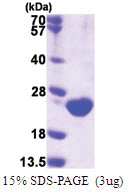DUSP3 (1-185, His-tag) Human Protein
Other products for "DUSP3"
Specifications
| Product Data | |
| Species | Human |
| Expression Host | E. coli |
| Expression cDNA Clone or AA Sequence |
MGSSHHHHHH SSGLVPRGSH MSGSFELSVQ DLNDLLSDGS GCYSLPSQPC NEVTPRIYVG NASVAQDIPK LQKLGITHVL NAAEGRSFMH VNTNANFYKD SGITYLGIKA NDTQEFNLSA YFERAADFID QALAQKNGRV LVHCREGYSR SPTLVIAYLM MRQKMDVKSA LSIVRQNREI GPNDGFLAQL CQLNDRLAKE GKLKP
|
| Tag | His-tag |
| Predicted MW | 22.6 kDa |
| Concentration | lot specific |
| Purity | >95% by SDS - PAGE |
| Presentation | Purified |
| Buffer | Presentation State: Purified State: Liquid purified protein Buffer System: 20 mM Tris-HCl buffer (pH 8.0) containing 10% glycerol, 2 mM DTT, 0.15M NaCl |
| Bioactivity | Specific: > 1,750 units/mg. Enzymatic activity was confirmed by measuring the amount of enzyme hydrolyzing 1 nmole of p-nitrophenyl phosphate (pNPP) per minute at 37°C, pH 7.5, using 10mM of substrate Activity Assay : 1. Prepare a 200 ul reaction mix into a suitable container: The final concentrations are 10mM Tris (pH7.5), 50mM NaCl, 2mM DTT, 1mM MnCl2, 10mM pNPP. 2. Pre - warm reaction mix in heat block at 37°C. 3. Add recombinant DUSP3 protein solution with various concentrations (1ug, 2ug, 3ug) in 200ul reaction buffer. 4. Mix by inversion and incubate at 37°C for 10 minutes. 5. Stop the reaction by adding the 800 ul of 0.1N NaOH and record the absorbance at 405nm. |
| Preparation | Liquid purified protein |
| Protein Description | Recombinant human DUSP3 protein, fused to His-tag at N-terminus, was expressed in E.coli and purified by using conventional chromatography techniques. |
| Storage | Store undiluted at 2-8°C for one week or (in aliquots) at -20°C to -80°C for longer. Avoid repeated freezing and thawing. |
| Stability | Shelf life: one year from despatch. |
| Reference Data | |
| RefSeq | NP_004081 |
| Locus ID | 1845 |
| UniProt ID | P51452 |
| Cytogenetics | 17q21.31 |
| Synonyms | VHR |
| Summary | The protein encoded by this gene is a member of the dual specificity protein phosphatase subfamily. These phosphatases inactivate their target kinases by dephosphorylating both the phosphoserine/threonine and phosphotyrosine residues. They negatively regulate members of the mitogen-activated protein (MAP) kinase superfamily (MAPK/ERK, SAPK/JNK, p38), which are associated with cellular proliferation and differentiation. Different members of the family of dual specificity phosphatases show distinct substrate specificities for various MAP kinases, different tissue distribution and subcellular localization, and different modes of inducibility of their expression by extracellular stimuli. This gene maps in a region that contains the BRCA1 locus which confers susceptibility to breast and ovarian cancer. Although DUSP3 is expressed in both breast and ovarian tissues, mutation screening in breast cancer pedigrees and in sporadic tumors was negative, leading to the conclusion that this gene is not BRCA1. [provided by RefSeq, Jul 2008] |
| Protein Families | Druggable Genome, Phosphatase |
| Protein Pathways | MAPK signaling pathway |
Documents
| FAQs |
| SDS |
Resources
Recombinant Protein Resources |
{0} Product Review(s)
0 Product Review(s)
Submit review
Be the first one to submit a review
Product Citations
*Delivery time may vary from web posted schedule. Occasional delays may occur due to unforeseen
complexities in the preparation of your product. International customers may expect an additional 1-2 weeks
in shipping.






























































































































































































































































 Germany
Germany
 Japan
Japan
 United Kingdom
United Kingdom
 China
China
